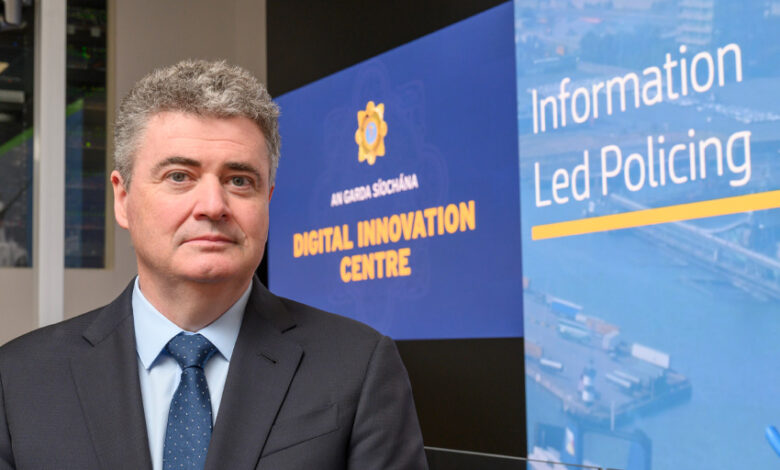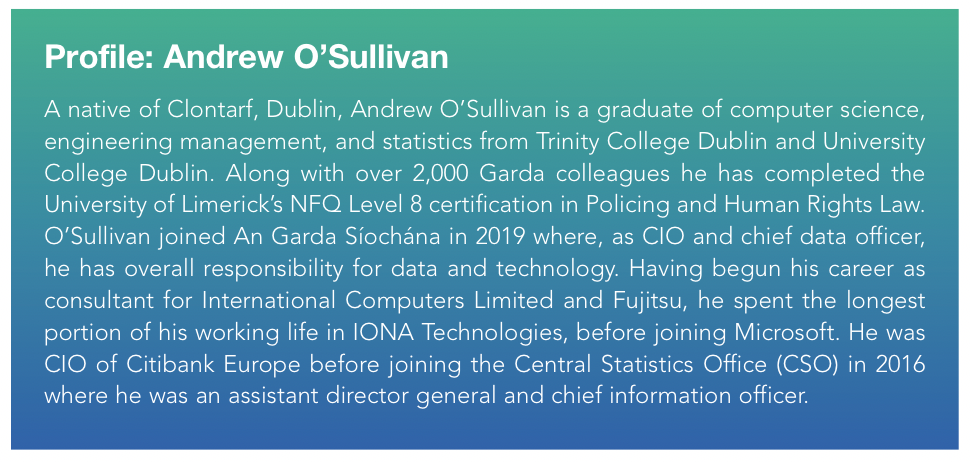Garda CIO Andrew O’Sullivan: Information led policing

Where society goes, crime goes, and where crime goes, policing must follow. In the context of the increasing digitalisation of society, Ciarán Galway sits down with CIO Andrew O’Sullivan at Garda Headquarters to discuss digital innovation and Information Led Policing.
Digitalisation in society has led to an explosive growth in data, both in terms of volume and complexity. From a policing perspective, has two key implications.
Firstly, the evolving expectations of citizens in relation to interactions with police, access to information, and transparency. Secondly, the increased availability of digital tools to criminals who are changing the ways in which they operate.
“Increasingly, it is much lower risk to engage in cybercrime than break into a house. If you scale that up, organised criminal gangs at the very top end are operating akin to software vendors.
“As such, we are now observing crime-as-a-service whereby smaller, local criminals will engage with an organised criminal gangs which will, in turn, outsource or offshore to a less than reputable software organisation, which will then provide them with scam tools and techniques.”
Digital evidence
Reiterating what the Garda National Cyber Crime Bureau previously told eolas Magazine, the CIO emphasises the reality that every single major investigation now has a digital component.
“Digital evidence, therefore, is a core aspect of policing. It has changed dramatically from a few hours of CCTV footage 10 years ago, to thousands of hours and in major investigations, it could be tens of thousands of hours of video footage. Likewise, it has changed from one or two text messages on a phone several years ago, to tens of thousands of emails and hundreds of thousands of images on an individual device,” he says.
“Policing must have access to electronic tools to be effective in dealing with the increasing volume of data. However, the first thing to understand is how we define digital because digital and electronic are not the same thing. Digitalisation is the combination, or a blending of the electronic world with the physical world,” the Garda CIO explains.
“Our digital policing strategy is about achieving the right blend of the electronic world and the physical world.”
Andrew O’Sullivan, Chief Information Officer and Chief Data Officer, An Garda Síochána
Computer-in-the-loop
Elaborating, O’Sullivan comments on the ineffectiveness of electronic tools in the absence of training, tradecraft, empathy, common-sense and a human rights-based approach to policing. “Our digital policing strategy is about achieving the right blend of the electronic world and the physical world,” he says, adding: “While ‘human-in-the-loop’ is a term used in computing to describe oversight of automated decisions, An Garda Síochána’s systems have taken that one step further.
“We use the term ‘computer-in-the-loop’ for decision-making. The computer is there only to support Garda personnel making decisions. This means that no machine ever makes a decision that could adversely impact an individual.”
Illustrating this, O’Sullivan references the GoSafe vans or automated speed detection. Contrary to popular belief, it is not an automated process. While GoSafe cameras detect and identify a potential speeding offence, that is then scrutinised by several pairs of human eyes before a sanction is issued.
Similarly, while the Garda vetting system now processes 500,000 applications each year, the decision support system used is limited to making suggestions to vetting agents that something may need to be examined before making a final decision.
“This human accountability is critical for maintaining exceptionally high public trust in An Garda Síochána. There is absolutely no question of machine decision-making. Rather, it is about supporting decision-making by accountable Garda personnel,” the CIO insists.
Data and technology branch
In response to digitalisation, An Garda Síochána has invested significantly in the expansion of its data and technology branch.
Headed up by the CIO, the branch employs approximately 1,000 staff across six enabling resources:
- Garda Information Services Centre (GISC)
- Information and Communications Technology
- Data Architecture
- Garda Síochána Analysis Service (GSAS)
- National Data Protection Office including the Freedom of Information Office
- Garda National Vetting Bureau
“We have invested heavily in the skills of our people over the last couple of years, both through internal training and education, focusing on the professional development of our data and technology professionals. We have also expanded from three principal officers to 13 plus one Director of ICT with recruitment for a GSAS Director to begin shortly. That investment and growth is going to continue,” O’Sullivan outlines.
Seeking to emulate vendors in the software industry in terms of adopting similar principles, practices, and career structures, the data and technology branch is “blending the best organisation design principles and the best professionalisation available” with the intrinsic value of the public service. “We are pursuing this in a way that sets the standards for international policing,” O’Sullivan asserts.
While the data and technology branch works closely with industry, it is primarily motivated to develop its in-house skills in cooperation with other agencies. “We know exactly what we want, and we have the expertise to oversee it. While we procure some products, we apply a very careful decision processes to ‘buy versus build’, and our preference is always to acquire something that already works elsewhere,” the CIO outlines.

Information led policing
In 2018, the Commission on the Future of Policing in Ireland’s published its final report. Under the Commission’s 10 principles for vision for the future of policing, the eighth principle asserts that policing must be information led.
The Future of Policing in Ireland acknowledged that:
- An Garda Síochána badly needs to introduce better business processes and systems for collecting, recording, managing, analysing, and disseminating information about crimes, incidents, complaints, finance, human resources, and other management issues;
- police and partner agencies need to share information effectively between themselves, and communicate with community partners;
- technology can provide the tools for this, as part of a comprehensive strategy for digital innovation;
- current Garda technology is outdated and inadequate to the detriment of both effective delivery of police services and efficient allocation of resources;
- data should be seen as a strategic asset and a key factor in determining policing decisions. In this way it should complement, not substitute for intuition and experience;
- professional data analysis is an essential tool in modern policing and should be available in each Garda division and in an enlarged Garda Analysis Service at Headquarters; and
- police should share information with their communities and partners.
A purely ICT strategy, Connect: An Garda Síochána’s Digital Strategy 2019-2023 has now been succeeded by Information Led Policing which is an overarching vision rather than a strategy.
“Building on the Commission on the Future of Policing in Ireland’s report, Information Led Policing is the destination that we want to get to,” the CIO notes. “From an implementation perspective, we take an agile development approach, with smaller individual projects in the service of the overarching vision. Does a particular project support us in advancing the vision from an innovation perspective? If the answer is no, then the project is dropped. If the answer is yes, then we progress with it.
“Every single project that we complete and hiring decision that we make is in the service of advancing the vision to deliver on the eighth principle of The Future of Policing in Ireland.”
“Information Led Policing is distinct from the style of a five-year change transformation programme. At the scale that we are operating at, it is impossible to have a single strategy or a single plan that is all encompassing. Instead, with a very clear vision, we can constantly kind of refine our projects in pursuit of that.”
How An Garda Síochána manages and organises the data it handles is a key component of Information Led Policing. “The whole vision is about implementing what are called data value chains. Business value chains turn raw materials into finished products and deliver them to customers. Data value chains use data as the raw material and turn it into information. Information is something that can be transformed into insight, which explains not just what happened, but why it happened. Ideally, again, this can be turned it into foresight, which is what is going to happen next and what you can do to influence that outcome,” the CIO observes.
Digital innovation
Digital innovation means invention plus practical application. The Covid pandemic provided huge impetus for An Garda Síochána to innovate very quickly. “While Covid was completely unwelcome, it was transformative from a cultural perspective and accelerated our data strategy. It opened eyes to the potential for the use of digital tools and remote working. Also, because we were getting data feeds in things like traffic patterns from Transport Infrastructure Ireland, it really accelerated the concept of acquiring data rather than simply collecting it from first principles.
“Garda personnel have demonstrated that they are extremely creative with how to use the tools at its disposal. In early 2020, prior to Covid, we were experimenting with videoconferencing. It was not something that was initially embraced because policing orthodoxy dictated for instance, that personnel should be present at crime scenes and in the same room to talk about major crimes and investigations, from the perspective of confidentiality.
Now, in geographically large divisions such as Cork County, rather than driving for more than an hour, superintendents who conduct early crime scene assessment can use mobile devices to videoconference with gardaí on the scene and make the decision as to as to what resources should be allocated. Likewise, almost every meeting from the Commissioner’s weekly management meeting downwards has a digital component.
In the last year, An Garda Síochána also had one of the biggest data centre moves in Irish public service history. “Historically, there were two data centres on site at Garda Headquarters. While one remains here, we have moved the other to a separate, secure location. Moving 20- or 30-year-old systems is a big deal because they are practically built into the fabric of the building. The fact that we were able to do that seamlessly was a big step forward.
“There is a concept in computing about having a fundamental core and then innovating around it. The data centres are a core that provide us with a strong basis for future innovation,” the CIO explains.
The mobile technology used by Garda personnel is another example of a fundamental core. Today, An Garda Síochána still has traditional desktop computers and some of these will always be needed. However, it is primarily focused on the use of laptops and smartphones which become a computer when plugged into a screen or lapdock (which resembles a laptop but with no storage or processor). This mobile platform puts An Garda Síochána in a very strong position to quickly develop new applications in response to policing needs. “As the mobile technology continues to evolve with improved computing power, we can leverage that,” he adds.
PULSE
Delivery of the Information Led Policing vision is underpinned by the deployment of technology. One milestone in 2022 and 2023 has been expanding beyond the PULSE, a core policing system used to records details of crime incidents on a central database.
“PULSE is a massive system and is categorised in computing terms as a classic legacy system in that it is mission critical for Garda operations but is also subject to a high rate of change. We are constantly innovating, and PULSE has effectively been completely re-engineered several times,” O’Sullivan asserts.
“Contrary to some discourse, we have no intention of replacing PULSE and it has evolved well over the last two decades,” O’Sullivan asserts. “However, the challenge is that PULSE was solely intended to be a crime incident recording system.”
CAD
Until recently, PULSE was An Garda Síochána’s only nationally linked database. Over the last year, it has been complemented by two other very large systems: firstly, the new Computer Aided Dispatch (CAD2) system and secondly, the Investigation Management System (IMS).
On the front end, the CAD2 system is in the process being rolled out in the Eastern Region and the Southern region, with the North Western region and the Dublin Metropolitan Region to follow.
Previously, control room dispatchers had four or more different computer systems on their desks, as well as a laptop for additional applications such as maps. None of these were integrated and it took considerable skills and coordination to dispatch a response to a 999 incident. Now, CAD2 locates the caller’s location on a map and recalls a history of previous incidents at that location and first responders will have an app on their mobile devices which displays this information. Dispatchers can now make better informed decisions on how to respond to a call for service.
“Computer Aided Dispatch is about collecting information from the very first point of contact. This reduces the pressure on PULSE because not every call turns out to be a crime. For instance, some calls are dealt with via a first line policing response. This is recorded by the CAD2 system. Similarly, proactive policing exercises, such as checks of licenced premises, can be recorded rather than everything ending up on PULSE,” the CIO explains.
IMS
On the back end then, the IMS is an electronic solution designed to regulate and support the administration and operation of investigations and specified operations conducted by An Garda Síochána arising from a PULSE incident.
“Instead of gardaí having to manually keep track of investigation related information, all evidence from individual investigations is digitised and made available to the investigation team. That has allowed us to move from paper-based files to mobile access.
“IMS is intended to standardise the management of investigations and operations from the initial reporting and recording of an incident on PULSE, to the conclusion. This will take time to fully bed in and we are constantly looking for ways to reduce the overhead on users who must log and record data,” O’Sullivan describes.
Ambition
Identifying the delivery of Information Led Policing as the most significant of his priorities, the CIO indicates that each of the groups within the data and technology branch has its own role to play. “It is really about people understanding our vision and then delivering on it. Every single project that we complete and hiring decision that we make is in the service of advancing the vision to deliver on the eighth principle of The Future of Policing in Ireland,” O’Sullivan remarks.
As was the experience of many public service agencies during the 2010s, in the wake of the Great Recession, An Garda Síochána underwent severe budget cuts and a dearth of innovation in technology,
In recent years, however, with a significant increase in funding, it is in advantageous position. “Having come from a position of not being able to modernise our technology, we are now able to leapfrog over what some other police services might have achieved.
“We must also increase our professional capabilities and hiring experts in areas such as data science and AI to ensure that we remain flexible and ready for the next waves of digitalisation because the thing about digitalisation is that it never stops. What we are doing today will evolve into something completely different in the future,” he concludes.






